Improved Packing Model for Functionally Graded Sand-Fines Mixtures—Incorporation of Fines Cohesive Packing Behavior
Abstract
1. Introduction
2. Background
2.1. Packing Model for Binary Mixtures
2.2. Incorporating Fines Cohesive Packing Behavior
3. Model Validation for Sand-Fines Mixtures
3.1. Evaluating the Critical Particle Size
3.2. Evaluating the Cohesive Packing Parameter “p”
4. Discussion
4.1. Ideal and Non-Ideal Packing for Sand-Fines Mixtures
4.2. Maximum Packing Density Prediction
4.3. Impact on Permeability
5. Conclusions
Funding
Acknowledgments
Conflicts of Interest
References
- Zhou, W.; Zhang, L.; Wu, P.; Cai, Y.; Zhao, X.; Yao, C. Study on Permeability Stability of Sand-Based Microporous Ceramic Filter Membrane. Materials 2019, 12, 2161. [Google Scholar] [CrossRef]
- Hwang, H.; Jeen, S.K.; Suleiman, A.A.; Lee, K. Comparison of Saturated Hydraulic Conductivity Estimated by Three Different Methods. Water 2017, 9, 942. [Google Scholar] [CrossRef]
- Ahn, J.; Jung, J. Effects of Fine Particles on Thermal Conductivity of Mixed Silica Sands. Appl. Sci. 2017, 7, 650. [Google Scholar] [CrossRef]
- Carrier, W.D. Goodbye, Hazen; Hello, Kozeny–Carman. J. Geotech. Geoenviron. Eng. 2003, 129, 1054–1056. [Google Scholar] [CrossRef]
- El-Husseiny, A.; Vanorio, T. Porosity-permeability relationship in dual porosity carbonate analogs. Geophysics 2017, 82, MR65–MR74. [Google Scholar] [CrossRef]
- Salgado, R.; Bandini, P.; Karim, A. Shear strength and stiffness of silty sand. J. Geotech. Geoenviron. Eng. 2000, 126, 451–462. [Google Scholar] [CrossRef]
- Selig, E.; Ladd, R. Evaluation of Relative Density Measurements and Applications: Evaluation of Relative Density and Its Role in Geotechnical Projects Involving Cohesionless Soils; ASTM International: West Conshohocken, PA, USA, 1973. [Google Scholar]
- Kamann, P.J.; Ritzi, R.W.; Dominic, D.F.; Conrad, C.M. Porosity and permeability in sediment mixtures. Groundwater 2007, 45, 429–438. [Google Scholar] [CrossRef]
- Kerimov, A.; Mavko, G.; Mukerji, T.; Dvorkin, J.; Al Ibrahim, M.A. The influence of convex particles’ irregular shape and varying size on porosity, permeability, and elastic bulk modulus of granular porous media: Insights from numerical simulations. J. Geophys. Res. Solid Earth 2018, 123, 10563–10582. [Google Scholar] [CrossRef]
- Alakayleh, Z.; Clement, P.; Fang, X. Understanding the Changes in Hydraulic Conductivity Values of Coarse- and Fine-Grained Porous Media Mixtures. Water 2018, 10, 313. [Google Scholar] [CrossRef]
- Kim, M.; Seo, H. Evaluation of one-and two-parameter models for estimation of void ratio of binary sand mixtures deposited by dry pluviation. Granular Matter 2019, 21, 71. [Google Scholar] [CrossRef]
- Moini, M.; Sobolev, K.; Flores-Vivian, I.; Amirjanov, A. Modeling and Experimental Evaluation of Aggregate Packing for Effective Application in Concrete. J. Mater. Civ. Eng. 2019, 31, 04019001. [Google Scholar] [CrossRef]
- Osuji, S.O.; Inerhunwa, I. Determination of optimum characteristics of binary aggregate mixtures. Civ. Environ. Res. 2015, 7, 68–75. [Google Scholar]
- Wang, J.; Hu, B.; Hwei, J.; Soon, J.H. Physical and Mechanical Properties of a Bulk Lightweight Concrete with Expanded Polystyrene (EPS) Beads and Soft Marine Clay. Materials 2019, 12, 1662. [Google Scholar] [CrossRef]
- Chang, C.S.; Wang, J.Y.; Ge, L. Modeling of minimum void ratio for sand-silt mixtures. Eng. Geol. 2015, 196, 293–304. [Google Scholar] [CrossRef]
- Bandini, P.; Sathiskumar, S. Effects of silt content and void ratio on the saturated hydraulic conductivity and compressibility of sand-silt mixtures. J. Geotech. Geoenviron. Eng. 2009, 135, 1976–1980. [Google Scholar] [CrossRef]
- Liu, Z.R.; Ye, W.M.; Zhang, Z.; Wang, Q.; Chen, Y.G.; Cui, Y.J. Particle size ratio and distribution effects on packing behavior of crushed GMZ bentonite pellets. Powder Technol. 2019, 351, 92–101. [Google Scholar] [CrossRef]
- Simpson, D.C.; Evans, T.M. Behavioral thresholds in mixtures of sand and Kaolinite clay. J. Geotech. Geoenviron. Eng. 2016, 142, 04015073. [Google Scholar] [CrossRef]
- Wu, W.; Li, W. Porosity of bimodal sediment mixture with particle filling. Int. J. Sediment Res. 2017, 32, 253–259. [Google Scholar] [CrossRef]
- Marion, D.; Nur, A.; Yin, H.; Han, D. Compressional velocity and porosity in sand-clay mixtures. Geophysics 1992, 57, 554–563. [Google Scholar] [CrossRef]
- Colby, B.R. Discussion of Sediment transportation mechanics: Introduction and properties of sediment”, Progress report by the Task Committee on Preparation of Sediment Manual of the Committee on Sedimentation of the Hydraulics Division, V.A.; Vanoni, Chmn. J. Hydraul. Div. 1963, 89, 266–268. [Google Scholar]
- Wu, W.; Wang, S.Y. Formulas for sediment porosity and settling velocity. J. Hydraul. Eng. 2006, 132, 858–862. [Google Scholar] [CrossRef]
- Yiming, Y.; Zhang, L.; Luo, X. Calculating the primary porosity of unconsolidated sands based on packing texture: Application to braided river sands. Mar. Pet. Geol. 2019, 107, 515–526. [Google Scholar] [CrossRef]
- Luijendijk, E.; Gleeson, T. How well can we predict permeability in sedimentary basins? Deriving and evaluating porosity–permeability equations for noncemented sand and clay mixtures. Geofluids 2015, 15, 67–83. [Google Scholar] [CrossRef]
- Revil, A.; Cathles, L.M. Permeability of shaly sands. Water Resour. Res. 1999, 35, 651–662. [Google Scholar] [CrossRef]
- Koltermann, C.E.; Gorelick, S.M. Fractional packing model for hydraulic conductivity derived from sediment mixtures. Water Resour. Res. 1995, 31, 3283–3297. [Google Scholar] [CrossRef]
- Konishi, C. Predictions of elastic and transport properties for unconsolidated sediments by gravel-sand-clay mixture model. In Proceedings of the Near-Surface Asia Pacific Conference, Waikoloa, HI, USA, 7–10 July 2015; pp. 180–183. [Google Scholar]
- Westman, A.E.R.; Hugill, H.R. The packing of particles. J. Am. Ceram. Soc. 1930, 13, 767–779. [Google Scholar] [CrossRef]
- Yu, A.; Standish, N.; Mclean, A. Porosity calculation of nonspherical particles. J. Am. Ceram. Soc. 1993, 76, 2813–2816. [Google Scholar] [CrossRef]
- Quaranta, N.; Caligaris, M.; Unsen, M.; López, H.; Pelozo, G.; Pasquini, J.; Vieira, C. Ceramic tiles obtained from clay mixtures with the addition of diverse metallurgical wastes. J. Mat. Sci. Chem. Eng. 2014, 2, 1. [Google Scholar] [CrossRef]
- Saengthong, C. Effect of sand addition on the properties of clay body for Traguan pottery. Suranaree J. Sci. Technol. 2017, 24, 321–325. [Google Scholar]
- El-Husseiny, A.; Vanorio, T.; Mavko, G. Predicting porosity of binary mixtures made out of irregular nonspherical particles: Application to natural sediments. Adv. Powder Technol. 2019, 30, 1558–1566. [Google Scholar] [CrossRef]
- Choo, H.; Lee, W.; Lee, C.; Burns, S.E. Estimating Porosity and particle size for hydraulic conductivity of binary mixed soils containing two different-sized silica particles. J. Geotech. Geoenviron. Eng. 2018, 144, 04017104. [Google Scholar] [CrossRef]
- Lade, P.V.; Liggio, C.D.; Yamamuro, J.A. Effects of non-plastic fines on minimum and maximum void ratios of sand. Geotech. Test. J. 1998, 21, 336–347. [Google Scholar]
- Zhang, Z.F.; Ward, A.L.; Keller, J.M. Determining the porosity and saturated hydraulic conductivity of binary mixtures. Vadose Zone J. 2011, 10, 313–321. [Google Scholar] [CrossRef]
- Yu, A.B.; Standish, N. Porosity calculation of multi-component mixtures of particles. Powder Technol. 1987, 52, 233–246. [Google Scholar] [CrossRef]
- Liu, Y.; Jeng, D. Pore Structure of Grain-Size Fractal Granular Material. Materials 2019, 12, 2053. [Google Scholar] [CrossRef]
- Knoll, M.D.; Knight, R. Relationships between dielectric and hydrogeologic properties of sand–clay mixtures. In Proceedings of the Fifth International Conferention on Ground Penetrating Radar, Kitchener, ON, Canada, 12–16 June 1994; pp. 45–61. [Google Scholar]
- Israelachvili, J.N. Intermolecular & Surface Forces, 2nd ed.; Academic Press: London, UK, 1991. [Google Scholar]
- Visser, J. Van der Waals and other cohesive forces affecting powder fluidization. Powder Technol. 1989, 58, 1–10. [Google Scholar] [CrossRef]
- Zou, R.P.; Gan, M.L.; Yu, A.B. Prediction of the porosity of multi-component mixtures of cohesive and non-cohesive particles. Chem. Eng. Sci. 2011, 66, 4711–4721. [Google Scholar] [CrossRef]
- Choo, H.; Burns, S.E. Effect of over consolidation ratio on dynamic properties of binary mixtures of silica particles. Soil Dyn. Earthquake Eng. 2014, 60, 44–50. [Google Scholar] [CrossRef]
- Evans, T.M.; Valdes, J.R. The microstructure of particulate mixtures in one-dimensional compression: Numerical studies. Granul. Matter 2011, 13, 657–669. [Google Scholar] [CrossRef]
- McGeary, R.K. Mechanical packing of spherical particles. J. Am. Ceram. Soc. 1961, 44, 513–522. [Google Scholar] [CrossRef]
- Yu, A.B.; Standish, N. Estimation of the porosity of particle mixtures by a linear-mixture packing model. Ind. Eng. Chem. Res. 1991, 30, 1372–1385. [Google Scholar] [CrossRef]
- Al-Shayea, N.A. The combined effect of clay and moisture content on the behavior of remolded unsaturated soils. Eng. Geol. 2001, 62, 319–342. [Google Scholar] [CrossRef]
- Malizia, J.P.; Shakoor, A. Effect of water content and density on strength and deformation behavior of clay soils. Eng. Geol. 2018, 244, 125–131. [Google Scholar] [CrossRef]
- Collins, K.; McGown, A. The form and function of microfabric features in a variety of natural soils. Geotechnique 1974, 24, 223–254. [Google Scholar] [CrossRef]
- Sun, W.J.; Zong, F.Y.; Sun, D.; Wei, Z.; Schanz, T.; Fatahi, B. Swelling prediction of bentonite-sand mixtures in the full range of sand content. Eng. Geol. 2017, 222, 146–155. [Google Scholar] [CrossRef]
- Dafalla, M.A. The Compressibility and Swell of Mixtures for Sand-Clay Liners. Adv. Mat. Sci. Eng. 2017, 2017, 3181794. [Google Scholar] [CrossRef]
- Zou, R.P.; Xu, J.Q.; Feng, C.L.; Yu, A.B.; Johnson, S.; Standish, N. Packing of multi-sized mixtures of wet coarse spheres. Powder Technol. 2003, 130, 77–83. [Google Scholar] [CrossRef]
- Cho, G.C.; Dodds, J.; Santamarina, J.C. Particle shape effects on packing density, stiffness, and strength: Natural and crushed sands. J. Geotech. Geoenviron. Eng. 2006, 132, 591–602. [Google Scholar] [CrossRef]
- Alvarez, E. Effects of Particle Weight, Size, Shape, and Size Distribution on Maximum Void Ratio. Master’s Thesis, University of California, Davis, CA, USA, 2016. [Google Scholar]
- Edil, T.B.; Krizek, R.J.; Zelasko, J.S. Effect of grain characteristics on packing of sands. Sour. Inf. Available 1975, 1, 46–54. [Google Scholar]
- Fuggle, A.; Roozbahani, M.; Frost, J. Size effects on the void ratio of loosely packed binary particle mixtures. In Geo-Congress 2014: Geo-Characterization and Modeling for Sustainability; ASCE: Atlanta, GA, USA, 2014; pp. 129–138. [Google Scholar]
- Yang, J.; Wei, L.M. Collapse of loose sand with the addition of fines: The role of particle shape. Géotechnique 2012, 62, 1111–1125. [Google Scholar] [CrossRef]
- Liu, H.; Yu, Q.; Pfeffer, R.; Gogos, C. Mixing and packing of fine particles of different sizes. Ind. Eng. Chem. Res. 2011, 50, 198–206. [Google Scholar] [CrossRef]
- Mizuno, M.; Fukaya, A.; Jimbo, G. The estimation of packing characteristics by centrifugal compaction of ultrafine particles. KONA Powder Part. 1991, 9, 19–27. [Google Scholar] [CrossRef][Green Version]
- Santamarina, J.C.; Cho, G.C. Soil behaviour: The role of particle shape. In Advances in Geotechnical Engineering: The Skempton Conference; Thomas Telford: London, UK, 2004; pp. 1–14. [Google Scholar]
- Yang, S.L.; Sandven, R.; Grande, L. Instability of sand-silt mixtures. Soil Dyn. Earthq. Eng. 2006, 26, 183–190. [Google Scholar] [CrossRef]
- Steiakakis, E.; Gamvroudis, C.; Komodromos, A.; Repouskou, E. Hydraulic conductivity of compacted kaolin–sand specimens under high hydraulic gradients. Electron. J. Geotech. Eng. 2012, 17, 783–799. [Google Scholar]
- Polito, C.P.; Martin, J.R. Effects of nonplastic fines on the liquefaction resistance of solids. J. Geotech. Geoenviron. Eng. 2001, 127, 408–415. [Google Scholar] [CrossRef]
- Zlatovic, S.; Ishihara, K. Normalized behavior of very loose non-plastic soils: Effects of fabric. Soils Found. 1997, 37, 47–56. [Google Scholar] [CrossRef]
- Thevanayagam, S.; Shenthan, T.; Mohan, S.; Liang, J. Undrained fragility of clean sands, silty sands and sandy silts. J. Geotech. Geoenviron. Eng. 2002, 128, 849–859. [Google Scholar] [CrossRef]
- Chang, C.S.; Meidani, M.; Deng, Y. A compression model for sand–silt mixtures based on the concept of active and inactive voids. Acta Geotech. 2017, 12, 1301–1317. [Google Scholar] [CrossRef]
- Konishi, Y.; Hyodo, M.; Ito, S. Compression and undrained shear characteristics of sand-fines mixtures with various plasticity. J. Geotech. Geoenviron. Eng. 2007, 63, 1142–1152. [Google Scholar] [CrossRef]
- Jafari, M.K.; Shafiee, A. Mechanical behaviour of compacted composite clays. Can. Geotech. J. 2004, 41, 1152–1167. [Google Scholar] [CrossRef]
- Tarantino, A.; De Col, E. Compaction behaviour of clay. Géotechnique 2008, 58, 199–213. [Google Scholar] [CrossRef]
- Chang, C.S.; Wang, J.Y.; Ge, L. Maximum and minimum void ratios for sand-silt mixtures. Eng. Geol. 2016, 211, 7–18. [Google Scholar] [CrossRef]
- Schruff, T.; Liang, R.; Rüde, U.; Schüttrumpf, H.; Frings, R.M. Generation of dense granular deposits for porosity analysis: Assessment and application of large-scale non-smooth granular dynamics. Comp. Part. Mech. 2018, 5, 59–70. [Google Scholar] [CrossRef]
- Chang, C.S.; Deng, Y.; Meidani, M. A multi-variable equation for relationship between limiting void ratios of uniform sands and morphological characteristics of their particles. Eng. Geol. 2018, 237, 21–31. [Google Scholar] [CrossRef]
- Patra, C.R.; Sivakugan, N.; Das, B.M.; Rout, S.K. Correlations for relative density of clean sand with median grain size and compaction energy. Int. J. Geotech. Eng. 2010, 4, 195–203. [Google Scholar] [CrossRef]
- Zou, R.P.; Yu, A.B. Evaluation of the packing characteristics of mono-sized non-spherical particles. Powder Technol. 1996, 88, 71–79. [Google Scholar] [CrossRef]
- Chapuis, R.P. Predicting the saturated hydraulic conductivity of soils: A review. Bull. Eng. Geol. Environ. 2012, 71, 401–434. [Google Scholar] [CrossRef]
- Ren, X.W.; Zhao, Y.; Deng, Q.L.; Kang, J.Y.; Li, D.X.; Wang, D.B. A relation of hydraulic conductivity-void ratio for soils based on Kozeny-Carman equation. Eng. Geol. 2016, 213, 89–97. [Google Scholar] [CrossRef]
- Das, B.M. Advanced Soil Mechanics; CRC Press: New York, NY, USA, 2008. [Google Scholar]
- Yin, H. Acoustic Velocity and Attenuation of Rocks: Isotropy, Intrinsic Anisotropy, and Stress Induced Anisotropy. Ph.D. Thesis, Stanford University, Stanford, CA, USA, 1992. [Google Scholar]
- Walling, D.E. The evolution of sediment source fingerprinting investigations in fluvial systems. J. Soils Sediments 2013, 13, 1658–1675. [Google Scholar] [CrossRef]
- Yang, H.; Shi, C. Sediment Grain-Size Characteristics and its Sources of Ten Wind-Water Coupled Erosion Tributaries (the Ten Kongduis) in the Upper Yellow River. Water 2019, 11, 115. [Google Scholar] [CrossRef]
- Baiyegunhi, C.; Liu, K.; Gwavava, O. Grain size statistics and depositional pattern of the Ecca Group sandstones, Karoo Supergroup in the Eastern Cape Province, South Africa. Open Geosci. 2017, 9, 554–576. [Google Scholar] [CrossRef]

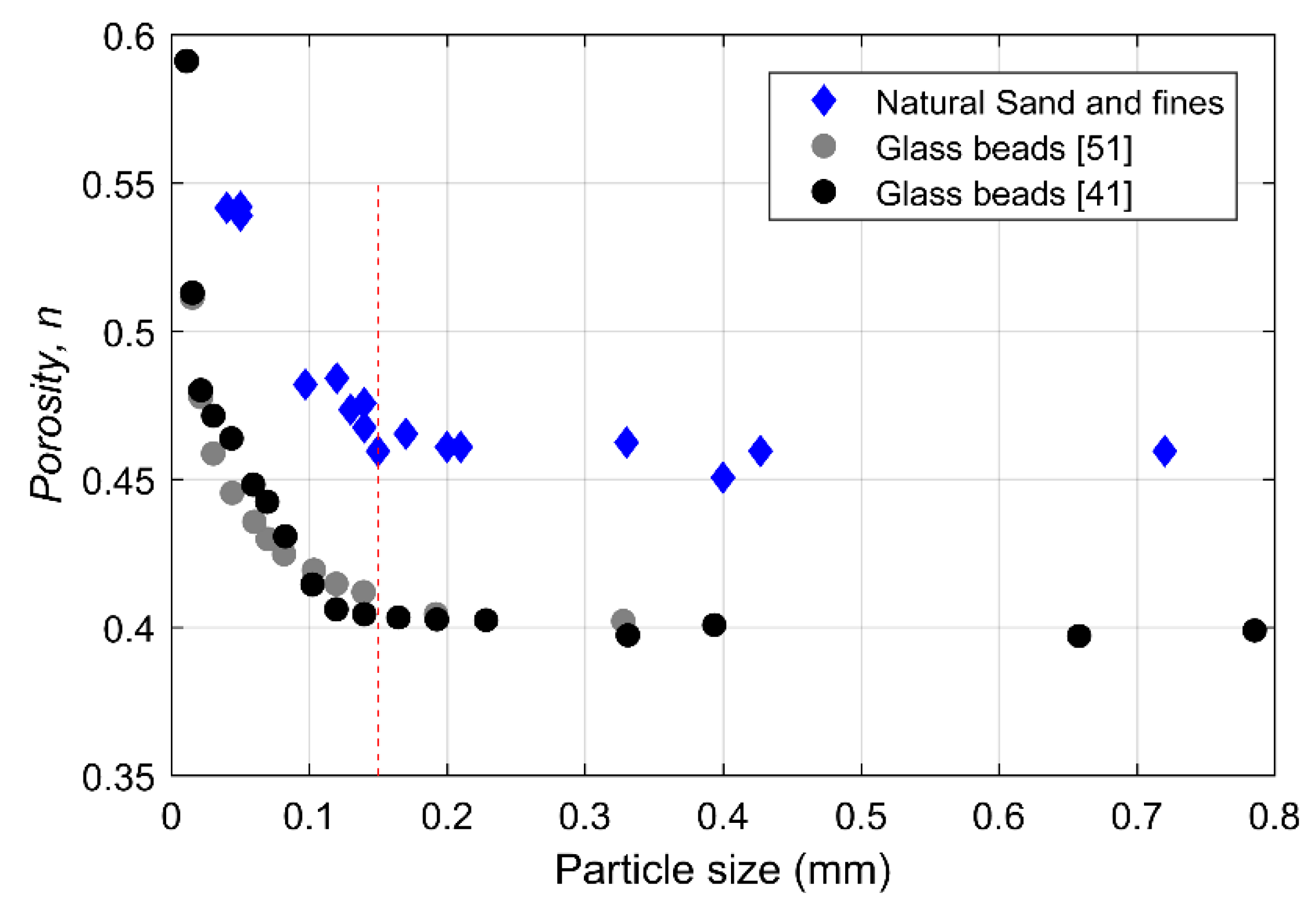
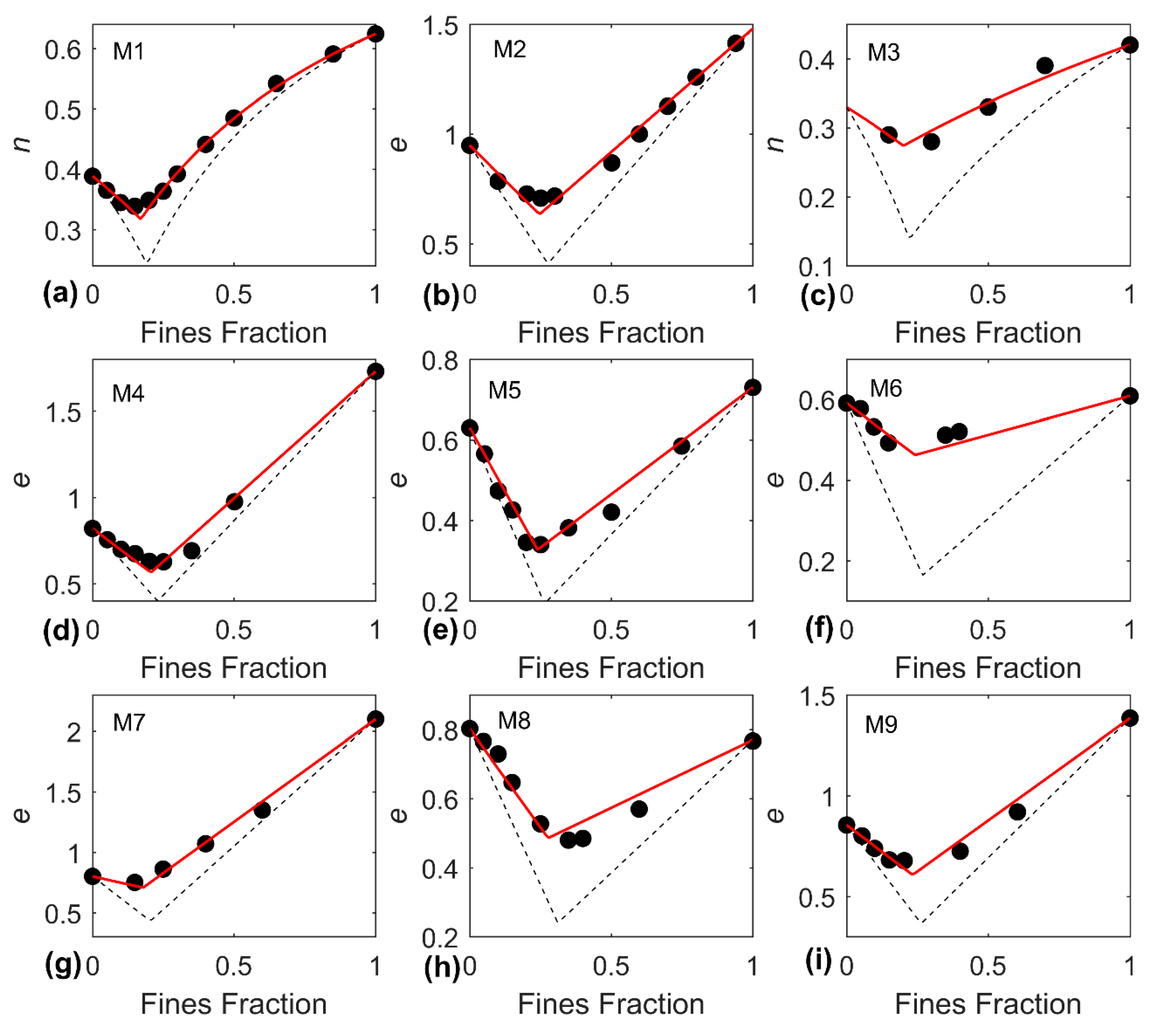
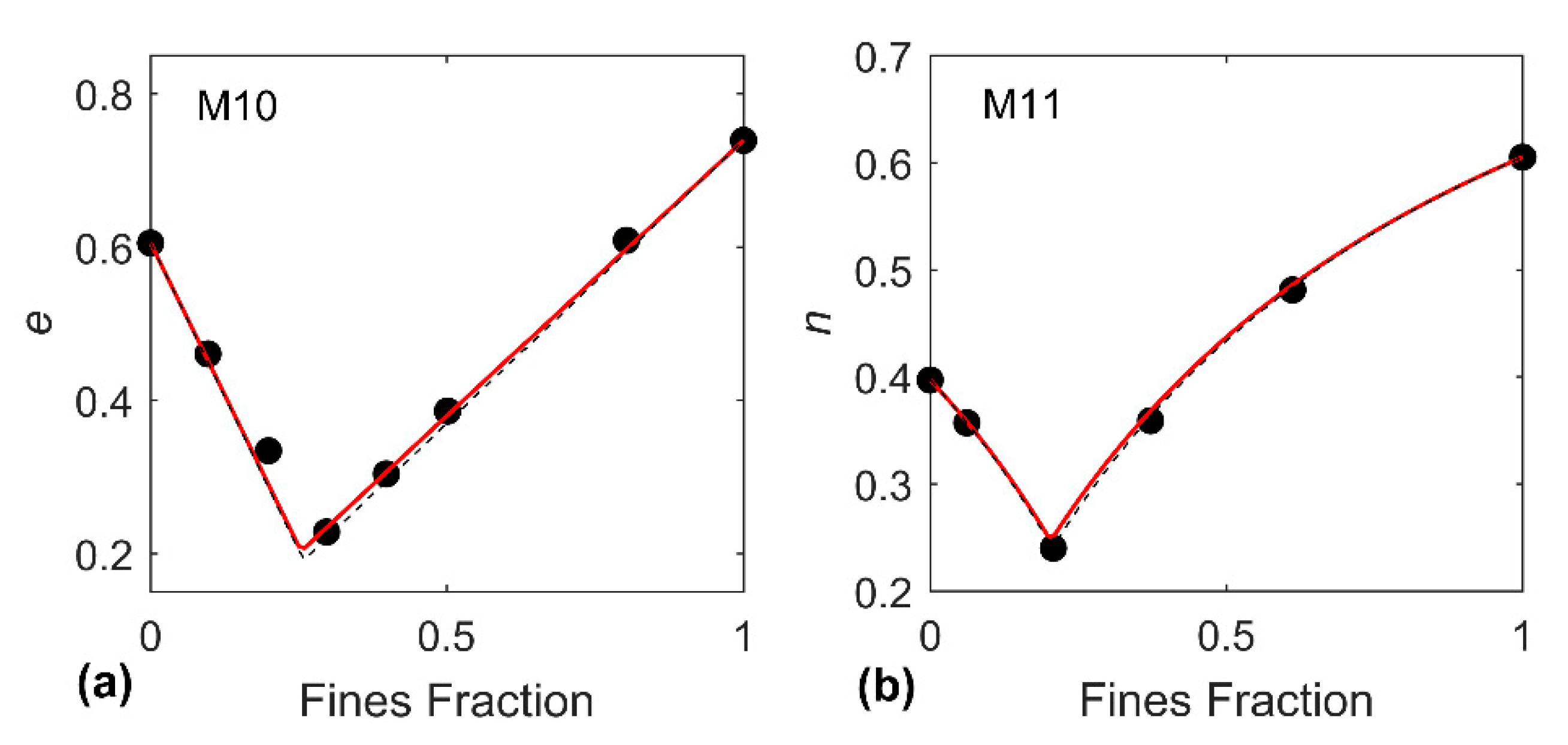
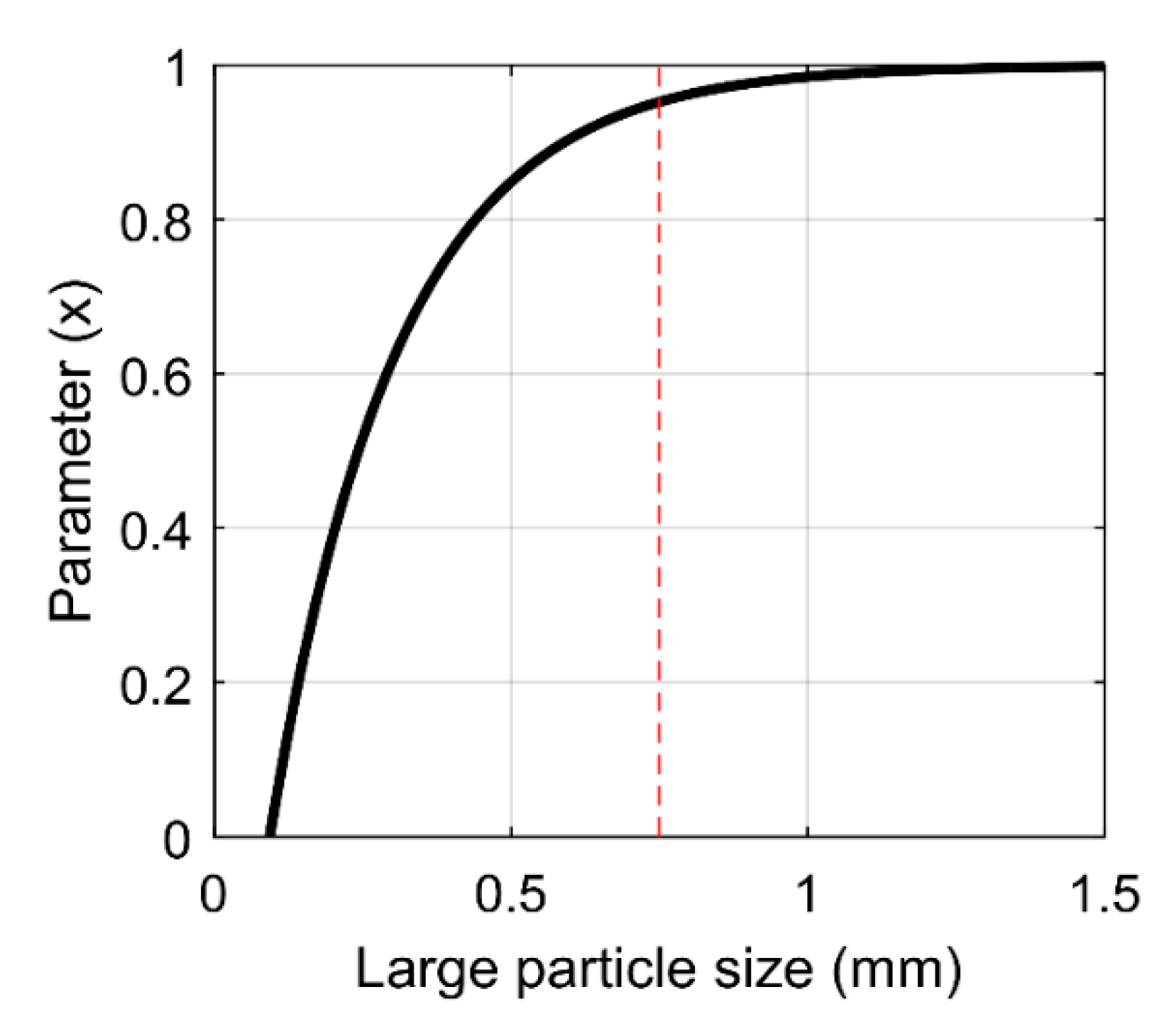
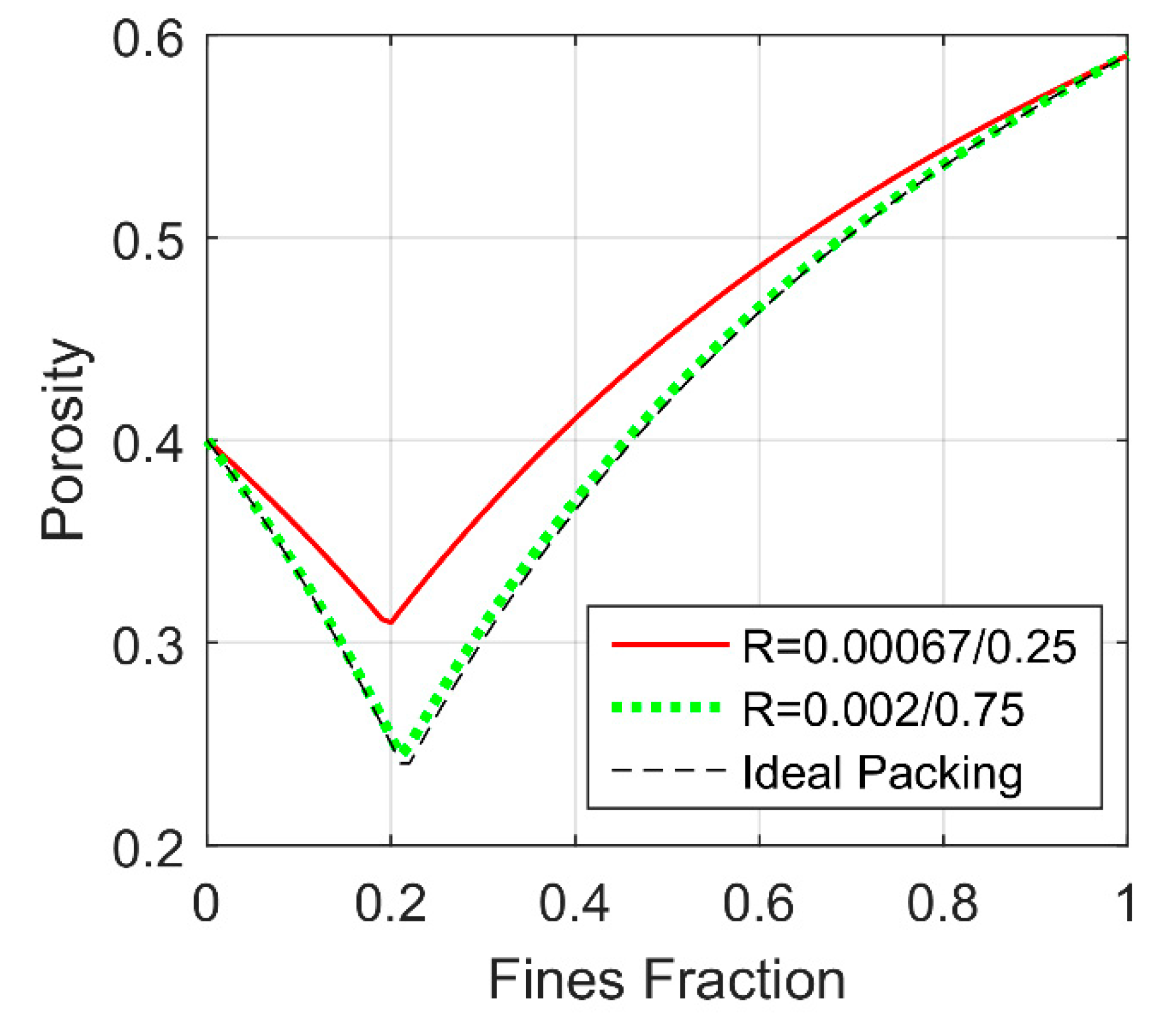
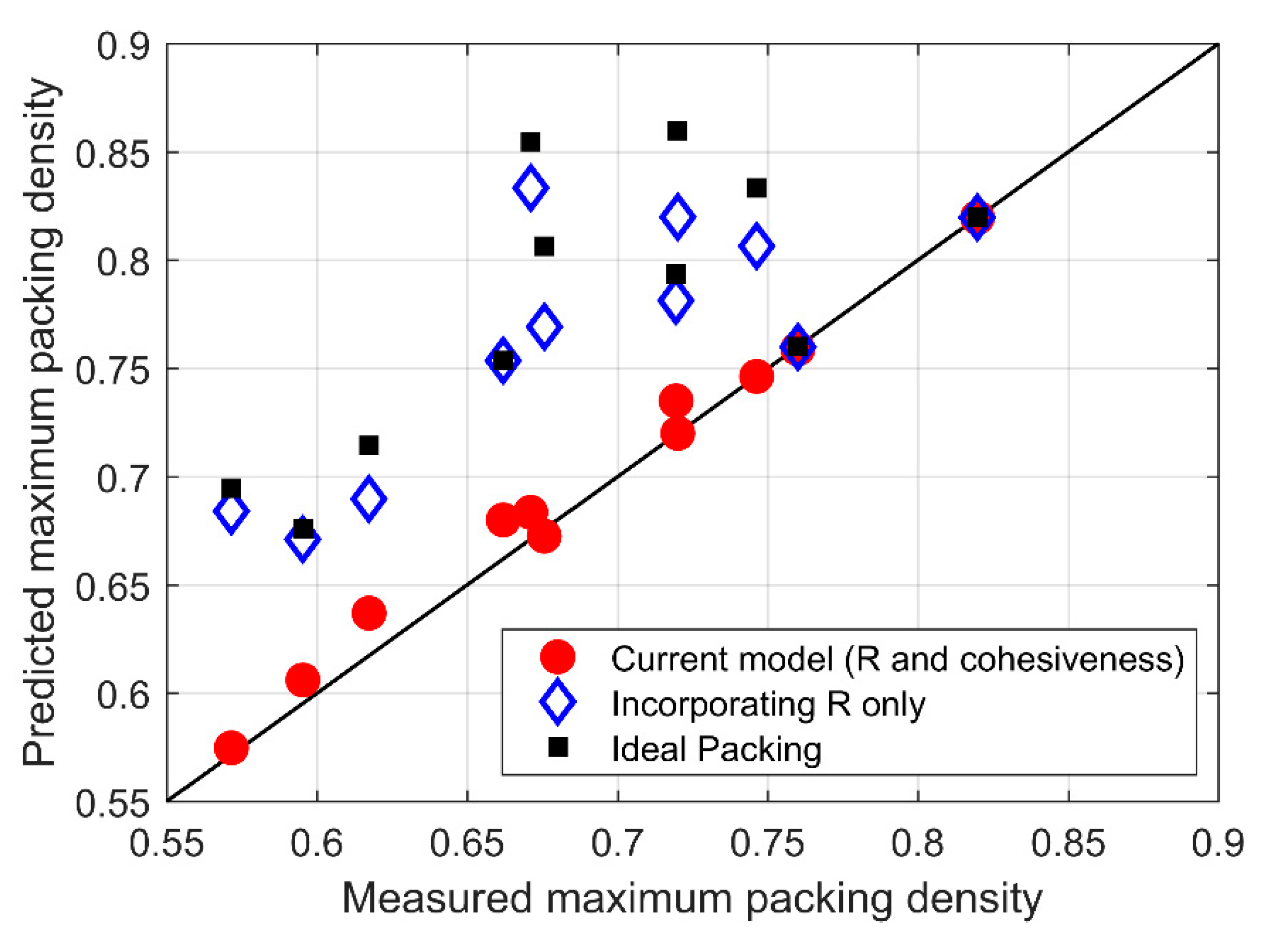
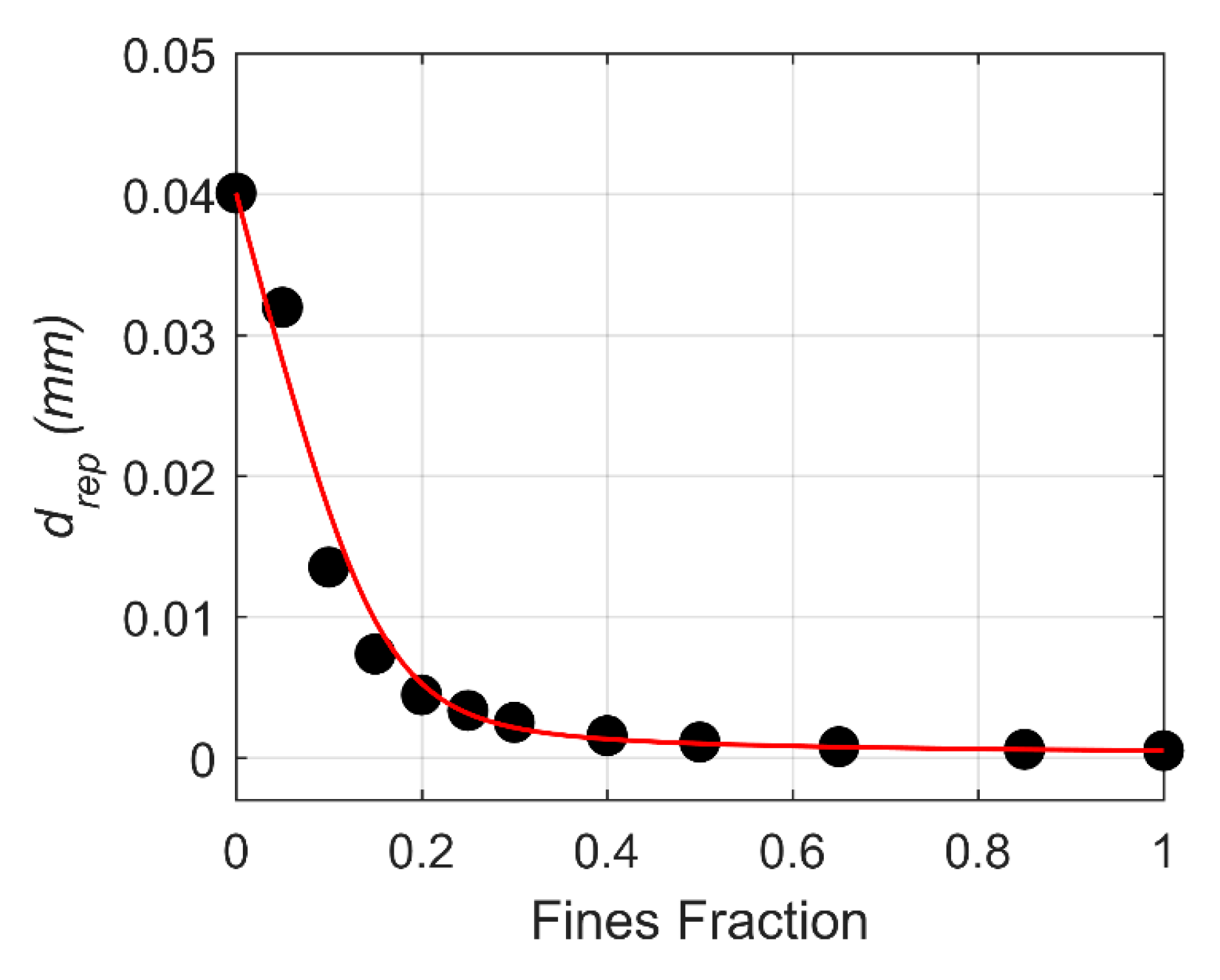
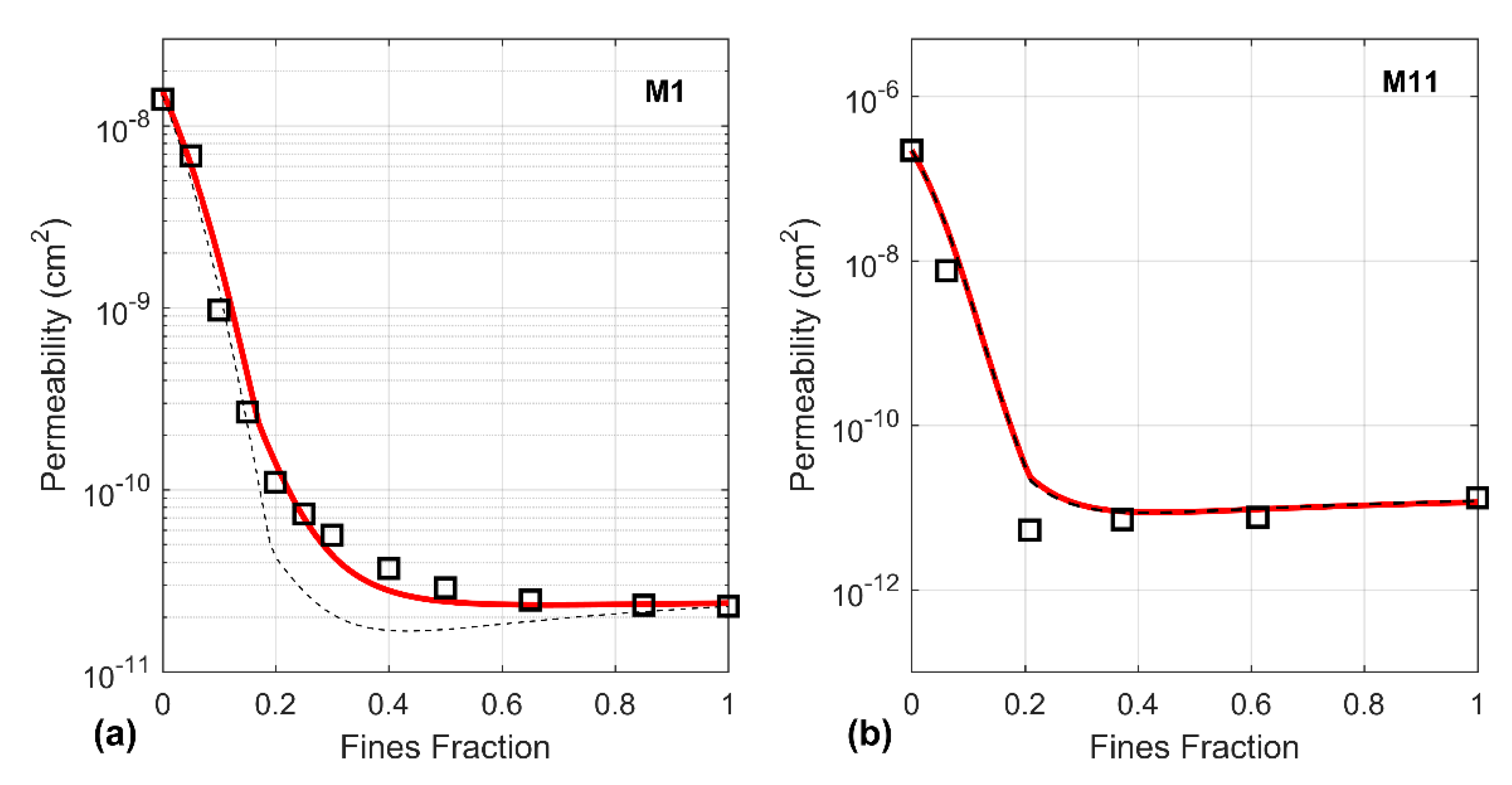
| Sand-Fines Mixture | Data Source | Packing | (mm) | (mm) | p | |||
|---|---|---|---|---|---|---|---|---|
| M1: Ottawa-Kaolinite | [20] | P | 0.280 | 0.0025 | 0.009 | 0.389 | 0.624 | 0.13 |
| M2: Hokksund sand-silt | [60] | P | 0.440 | 0.032 | 0.073 | 0.949 | 1.48 | 0.13 |
| M3: Crushed sand-Kaolinite | [61] | T | 0.250 | 0.025 | 0.1 | 0.33 | 0.42 | 0.17 |
| M4: Monterey sand-silt | [62] | P | 0.430 | 0.030 | 0.07 | 0.82 | 1.73 | 0.14 |
| M5: Monterey sand-silt | [62] | T | 0.430 | 0.030 | 0.07 | 0.63 | 0.73 | 0.15 |
| M6: Toyoura sand-silt | [63] | T | 0.170 | 0.010 | 0.059 | 0.591 | 0.609 | 0.15 |
| M7: Foundry sand-silt | [64] | T | 0.250 | 0.010 | 0.04 | 0.8 | 2.1 | 0.15 |
| M8:Assyros sand-silt | [62] | T | 0.300 | 0.020 | 0.067 | 0.802 | 0.77 | 0.17 |
| M9: Fujian sand-crushed silica | [56] | P | 0.427 | 0.061 | 0.1 | 0.855 | 1.385 | 0.15 |
| M10: Large-fine washed sand | [28] | P | 4.470 | 0.090 | 0.02 | 0.605 | 0.739 | [0:1] |
| M11: Sand-Kaolinite | [38] | P | 0.750 | 0.002 | 0.003 | 0.4 | 0.6 | [0:1] |
© 2020 by the author. Licensee MDPI, Basel, Switzerland. This article is an open access article distributed under the terms and conditions of the Creative Commons Attribution (CC BY) license (http://creativecommons.org/licenses/by/4.0/).
Share and Cite
El-Husseiny, A. Improved Packing Model for Functionally Graded Sand-Fines Mixtures—Incorporation of Fines Cohesive Packing Behavior. Appl. Sci. 2020, 10, 562. https://doi.org/10.3390/app10020562
El-Husseiny A. Improved Packing Model for Functionally Graded Sand-Fines Mixtures—Incorporation of Fines Cohesive Packing Behavior. Applied Sciences. 2020; 10(2):562. https://doi.org/10.3390/app10020562
Chicago/Turabian StyleEl-Husseiny, Ammar. 2020. "Improved Packing Model for Functionally Graded Sand-Fines Mixtures—Incorporation of Fines Cohesive Packing Behavior" Applied Sciences 10, no. 2: 562. https://doi.org/10.3390/app10020562
APA StyleEl-Husseiny, A. (2020). Improved Packing Model for Functionally Graded Sand-Fines Mixtures—Incorporation of Fines Cohesive Packing Behavior. Applied Sciences, 10(2), 562. https://doi.org/10.3390/app10020562





